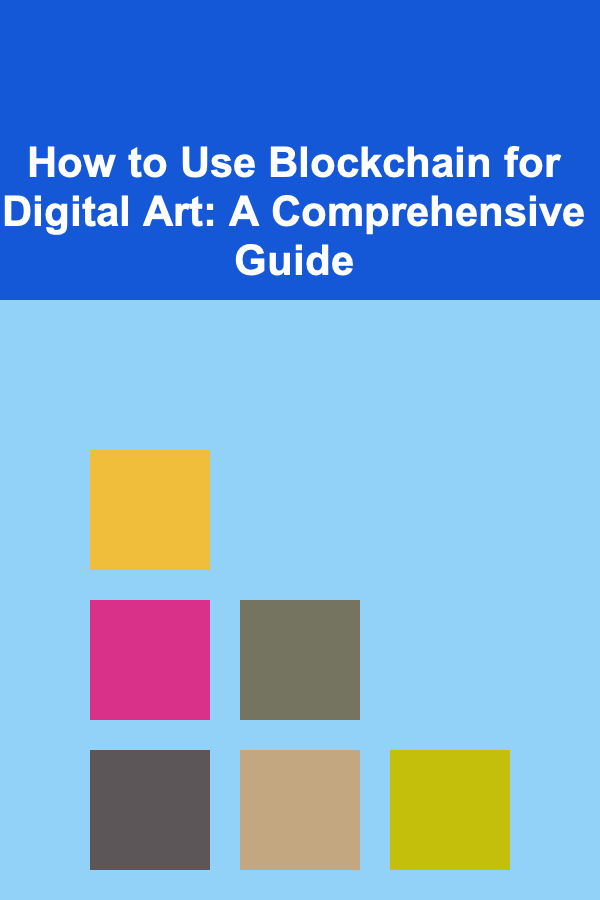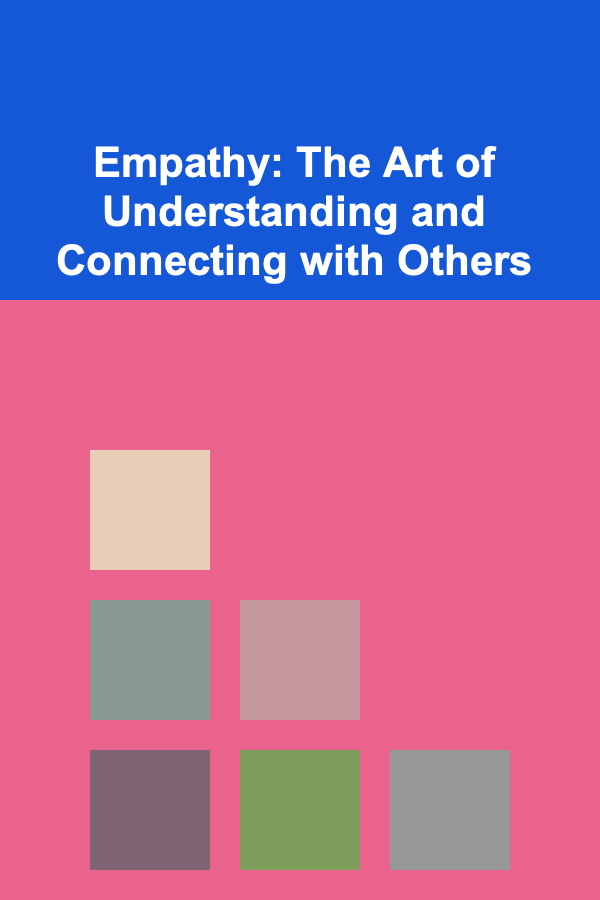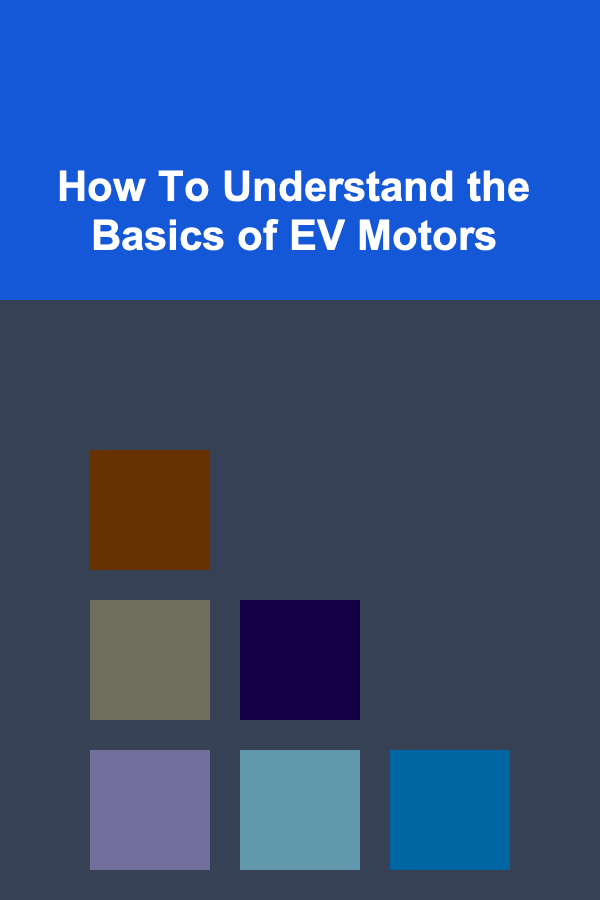
How to Use Blockchain for Digital Art: A Comprehensive Guide
ebook include PDF & Audio bundle (Micro Guide)
$12.99$5.99
Limited Time Offer! Order within the next:

The intersection of digital art and blockchain technology has revolutionized the art world, offering artists new avenues for monetization, provenance tracking, and direct engagement with their audience. This article provides a comprehensive exploration of how blockchain can be leveraged to empower digital artists, covering everything from the fundamental concepts to practical implementation and future trends.
Understanding the Fundamentals
What is Blockchain Technology?
At its core, a blockchain is a decentralized, distributed, and immutable ledger. Instead of relying on a central authority like a bank or art dealer, information is recorded across a network of computers, making it extremely difficult to tamper with or alter. Each "block" in the chain contains a set of transactions and a cryptographic hash of the previous block, forming a chronological and tamper-proof record. This inherent security and transparency make blockchain ideal for establishing ownership and authenticity in the digital realm.
Key characteristics of blockchain technology include:
- Decentralization: No single entity controls the network.
- Immutability: Once a block is added to the chain, it cannot be altered or deleted.
- Transparency: All transactions are publicly visible (though pseudonymous).
- Security: Cryptographic techniques secure the data and prevent unauthorized access.
What are NFTs?
Non-Fungible Tokens (NFTs) are cryptographic tokens that represent a unique asset on a blockchain. "Non-fungible" means that each token is distinct and cannot be directly exchanged for another on a one-to-one basis, unlike fungible tokens like Bitcoin or Ether. NFTs can represent a wide range of digital assets, including:
- Digital artwork (images, animations, videos)
- Music
- Virtual real estate
- Collectibles
- In-game items
The key to an NFT's value lies in its verifiable scarcity and ownership. Because it's recorded on the blockchain, its authenticity and provenance can be easily traced back to its creator. This is crucial for digital art, where copies can be easily made and distributed, making it difficult to establish originality.
NFTs operate on various blockchain platforms, with Ethereum being the most popular. Other platforms include Solana, Tezos, Cardano, and Flow, each offering different features and transaction costs.
Smart Contracts: The Engine Behind NFTs
Smart contracts are self-executing contracts written in code and stored on a blockchain. They automatically execute the terms of an agreement when predetermined conditions are met. For NFTs, smart contracts define the properties of the token, including:
- Ownership
- Metadata (descriptive information about the artwork, such as title, artist, description, and creation date)
- Royalties (percentages paid to the artist on secondary sales)
- Transfer rules
Smart contracts ensure that artists receive royalties on secondary sales, which is a significant benefit compared to traditional art markets where artists often don't profit from resales of their work. They also automate the process of transferring ownership and distributing payments.
Using Blockchain for Digital Art: A Step-by-Step Guide
1. Creating Digital Art for NFTs
The first step is, of course, creating the digital artwork itself. The possibilities are endless, encompassing various forms of digital media:
- Digital Paintings and Illustrations: Created using software like Adobe Photoshop, Procreate, or Krita.
- 3D Art and Sculptures: Designed with tools such as Blender, Maya, or ZBrush.
- Animation and Video: Produced using software like Adobe After Effects, Cinema 4D, or DaVinci Resolve.
- Generative Art: Algorithms create unique and unpredictable artwork, often using programming languages like Processing or p5.js.
- Photography: Digital photographs can be minted as NFTs.
- Music: Audio files can be associated with NFTs.
Consider these factors when creating digital art for NFTs:
- File Format: Common formats include JPG, PNG, GIF, MP4, and WAV. Choose a format that preserves the quality of your artwork.
- File Size: Larger files can result in higher minting and transaction fees. Optimize your files for the web without sacrificing too much quality.
- Resolution: Ensure your artwork has sufficient resolution for display on various devices.
- Unique Attributes: What makes your artwork stand out? Consider incorporating unique elements that will appeal to collectors.
2. Choosing a Blockchain Platform
Selecting the right blockchain platform is crucial. Each platform has its own characteristics, advantages, and disadvantages:
- Ethereum: The most popular platform for NFTs, offering a large and active community, robust infrastructure, and a wide range of tools and marketplaces. However, Ethereum can suffer from high gas fees (transaction costs), especially during periods of high network activity.
- Solana: Known for its high transaction speeds and low gas fees, making it an attractive alternative to Ethereum. Solana's ecosystem is growing rapidly, but it's still less mature than Ethereum's.
- Tezos: An energy-efficient blockchain with low gas fees and on-chain governance, making it a sustainable choice for artists.
- Cardano: A proof-of-stake blockchain known for its security and scalability. Cardano's NFT ecosystem is growing.
- Flow: Designed specifically for NFTs and gaming, offering a user-friendly experience and low transaction fees. Flow is the blockchain behind NBA Top Shot.
- Polygon (Matic): A Layer-2 scaling solution for Ethereum that offers faster and cheaper transactions. It is often used to mitigate Ethereum's high gas fees.
Factors to consider when choosing a platform:
- Gas Fees: How much will it cost to mint and transfer NFTs?
- Transaction Speed: How quickly will transactions be processed?
- Ecosystem: What marketplaces are available on the platform? Is there a strong community of artists and collectors?
- Environmental Impact: Some blockchains, like Ethereum (before the Merge), use a proof-of-work consensus mechanism that consumes a significant amount of energy. Consider choosing a more environmentally friendly blockchain like Tezos or a proof-of-stake chain.
- Smart Contract Capabilities: Does the platform support the features you need, such as royalties and programmable art?
3. Creating a Crypto Wallet
A crypto wallet is essential for interacting with blockchain platforms and managing your NFTs. It allows you to store your cryptocurrency (e.g., ETH, SOL, XTZ) and sign transactions. There are two main types of crypto wallets:
- Software Wallets (Hot Wallets): These are applications that you install on your computer or smartphone. They are convenient for everyday use but are generally considered less secure than hardware wallets because they are connected to the internet. Examples include MetaMask, Trust Wallet, and Phantom.
- Hardware Wallets (Cold Wallets): These are physical devices that store your private keys offline, making them much more secure. Examples include Ledger and Trezor.
When setting up a crypto wallet, you will be given a "seed phrase" (also known as a recovery phrase). This is a list of 12 or 24 words that can be used to recover your wallet if you lose access to it. It is crucial to store your seed phrase in a safe and secure place, offline. Never share your seed phrase with anyone.
4. Minting Your Digital Art as an NFT
Minting is the process of creating an NFT from your digital art. This involves uploading your artwork to a blockchain platform and associating it with a smart contract. There are several ways to mint NFTs:
- Directly on a Blockchain Platform: Some platforms, like Ethereum, allow you to mint NFTs directly using tools like OpenSea's collection manager (for "lazy minting", explained below) or Manifold Studio.
- Through NFT Marketplaces: Many NFT marketplaces offer minting services. These marketplaces often provide user-friendly interfaces and tutorials to guide you through the process. Examples include OpenSea, Rarible, Foundation, and SuperRare.
- Using Custom Smart Contracts: For more advanced control over the NFT's properties and functionality, you can write your own smart contract and deploy it to the blockchain. This requires programming knowledge and is typically done by developers or specialized NFT creation services.
Here's a general overview of the minting process:
- Connect your crypto wallet to the platform or marketplace.
- Upload your digital art file.
- Enter the NFT's metadata, including title, description, artist name, creation date, and any other relevant information. This metadata is crucial for searchability and discoverability.
- Set the royalty percentage. This determines the percentage you will receive on secondary sales.
- Choose the blockchain network (e.g., Ethereum, Solana).
- Approve the transaction in your crypto wallet and pay the gas fees.
- Once the transaction is confirmed, your NFT will be minted and added to your wallet.
Lazy Minting
Lazy minting is a technique where the NFT is not actually minted on the blockchain until it is purchased. This can significantly reduce upfront costs, especially on platforms like Ethereum with high gas fees. OpenSea's collection manager utilizes lazy minting. The NFT's metadata is stored off-chain, and it's only minted when a buyer purchases it, at which point the buyer typically pays the gas fees.
5. Listing Your NFT for Sale
Once your NFT is minted, you can list it for sale on an NFT marketplace. Popular marketplaces include:
- OpenSea: The largest NFT marketplace, supporting a wide range of blockchains and NFT types.
- Rarible: A community-governed marketplace that allows users to create and trade NFTs.
- Foundation: A curated marketplace focused on high-quality digital art. Artists typically need an invitation to join.
- SuperRare: A curated marketplace for unique, single-edition digital artwork.
- Nifty Gateway: Known for its curated drops and partnerships with established artists.
- LooksRare: A community-first NFT marketplace that rewards traders with LOOKS tokens.
When listing your NFT for sale, consider the following:
- Pricing: Research the market and price your NFT competitively. Consider the rarity, demand, and perceived value of your artwork. You can choose a fixed price or set up an auction.
- Listing Duration: If you're using an auction format, choose an appropriate duration for the auction.
- Description: Write a compelling description that highlights the unique features and significance of your artwork.
- Metadata: Ensure that the metadata is accurate and complete. This will help potential buyers find your NFT.
6. Promoting Your Digital Art
Listing your NFT on a marketplace is just the first step. You need to actively promote your work to attract buyers. Here are some effective strategies:
- Social Media: Share your artwork on social media platforms like Twitter, Instagram, TikTok, and Discord. Use relevant hashtags and engage with the NFT community.
- NFT Communities: Join NFT communities on Discord and Telegram. Share your work and participate in discussions.
- Online Galleries: Showcase your artwork on online galleries and portfolio websites.
- Collaborations: Collaborate with other artists or influencers to reach a wider audience.
- Press Releases: If you have a significant project or announcement, consider issuing a press release to art publications and blogs.
- Paid Advertising: Consider using paid advertising on social media or search engines to target potential buyers.
- Virtual Exhibitions: Participate in virtual art exhibitions and galleries within metaverse platforms.
Building a strong online presence is crucial for success in the NFT art world. Engage with your audience, respond to comments, and be active in the community.
Advanced Techniques and Considerations
Programmable Art and Dynamic NFTs
Programmable art refers to NFTs that can change their appearance or functionality based on certain conditions or events. This opens up exciting possibilities for creating dynamic and interactive artwork. Examples include:
- Time-Based Art: The artwork changes over time, revealing different layers or animations.
- Weather-Dependent Art: The artwork changes based on real-time weather data.
- Interactive Art: Users can interact with the artwork, triggering changes in its appearance or behavior.
Dynamic NFTs (dNFTs) are NFTs that can be updated or modified over time. This allows for greater flexibility and interactivity. For example, a dNFT could represent a character in a game that evolves as the player progresses.
Fractionalized NFTs
Fractionalized NFTs allow you to divide ownership of a single NFT into multiple tokens. This makes it easier for collectors to invest in high-value artwork and allows artists to share ownership with their community. Fractionalization can be achieved using platforms like Fractional.art.
NFT Royalties
NFT royalties are a crucial mechanism for compensating artists on secondary sales of their work. Smart contracts automatically distribute a percentage of the sale price to the original creator. However, royalty enforcement can be complex. Some marketplaces are exploring optional royalty models, which has sparked debate within the NFT community. Artists need to carefully consider the royalty terms offered by different marketplaces.
Copyright and Legal Considerations
While NFTs provide a means of verifying ownership, they do not automatically grant copyright. Copyright remains with the original creator of the artwork unless explicitly transferred. It's important to understand your rights as an artist and to clearly define the terms of use for your NFTs. Consider consulting with a legal professional to ensure you are protecting your intellectual property.
Some key considerations regarding copyright and NFTs:
- Copyright Ownership: The NFT represents ownership of the token, not necessarily the copyright to the underlying artwork.
- Terms of Service: Carefully review the terms of service of NFT marketplaces and platforms.
- Smart Contract Terms: Ensure that the smart contract accurately reflects your intended terms of use, including licensing rights.
- DMCA Takedown Notices: If your artwork is being used without your permission, you may be able to issue a DMCA takedown notice to have it removed from the infringing website or platform.
Environmental Impact of NFTs
The environmental impact of NFTs has been a major concern, particularly for blockchains that use a proof-of-work consensus mechanism like Ethereum (before the Merge). Proof-of-work requires significant computational power, resulting in high energy consumption. However, many blockchains are transitioning to more energy-efficient consensus mechanisms like proof-of-stake, which significantly reduces their environmental footprint.
Here are some ways to reduce the environmental impact of NFTs:
- Choose energy-efficient blockchains: Opt for blockchains that use proof-of-stake or other low-energy consensus mechanisms.
- Use Layer-2 scaling solutions: Layer-2 solutions like Polygon can reduce gas fees and energy consumption on Ethereum.
- Offset your carbon footprint: Consider purchasing carbon offsets to compensate for the environmental impact of your NFT activities.
The Future of Blockchain and Digital Art
The intersection of blockchain and digital art is still in its early stages, and the future holds exciting possibilities. Here are some emerging trends and potential developments:
- Metaverse Integration: NFTs will play a crucial role in the metaverse, representing virtual assets and enabling new forms of digital ownership and interaction.
- AR/VR NFTs: NFTs can be used to represent augmented reality and virtual reality experiences, allowing users to own and trade digital worlds.
- AI-Generated Art NFTs: The combination of artificial intelligence and NFTs will lead to the creation of unique and personalized artwork.
- DeFi and NFTs: Decentralized finance (DeFi) and NFTs are converging, creating new opportunities for lending, borrowing, and yield farming with NFTs.
- Improved Scalability and Interoperability: Ongoing developments in blockchain technology will improve scalability and interoperability, making NFTs more accessible and user-friendly.
- More sophisticated smart contracts: Further development of smart contracts will enable more complex and dynamic NFT functionalities, including decentralized autonomous organizations (DAOs) managing art collections and automated royalty distribution.
- Increased Regulation: As the NFT market matures, increased regulation is likely to occur, focusing on consumer protection, anti-money laundering, and tax compliance.
Conclusion
Blockchain technology offers a powerful toolset for digital artists, empowering them to establish ownership, monetize their work, and connect directly with their audience. By understanding the fundamentals of blockchain and NFTs, and by following the steps outlined in this guide, artists can navigate the exciting and evolving landscape of digital art. While challenges remain, the potential for blockchain to transform the art world is undeniable. Embrace the technology, experiment with new forms of creative expression, and contribute to the future of art.

Empathy: The Art of Understanding and Connecting with Others
Read More
How to Optimize Your Workspace with Ergonomic Solutions
Read More
How to Start Budgeting for a New Home Purchase
Read More
How to Teach Kids to Clean Up After Crafting
Read More
How To Use Apps to Optimize Your Schedule
Read More
How To Understand the Basics of EV Motors
Read MoreOther Products

Empathy: The Art of Understanding and Connecting with Others
Read More
How to Optimize Your Workspace with Ergonomic Solutions
Read More
How to Start Budgeting for a New Home Purchase
Read More
How to Teach Kids to Clean Up After Crafting
Read More
How To Use Apps to Optimize Your Schedule
Read More